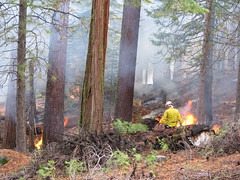| Fire Yosemite (Photo credit: Rennett Stowe) |
The frequency of large wildfires in the western US have been increasing over the past several decades.
The Rim Fire, currently threatening the Hetch Hetchy reservoir in Yosemite National Park, is an example of two factors that are contributing to this increase.
Dense forests with substantial amounts of needle cast and branches on the forest floor (referred to as fuels by forest managers) coupled with drought are the major contributors to many of these large wildfires.
Fire is no stranger to California’s Sierra Nevada. In fact, much of the forest in the Sierra was historically maintained by fire. The major difference between historical natural fires and today’s large wildfires is the severity with which these modern wildfires burn.
Prior to the implementation of US Government policy to put wildfires out, fires on average burned through the ponderosa pine and mixed-conifer forests of the Sierra Nevada every 8-35 years.
This regular natural event consumed the fuel - dry wood and pine needles - on the forest floor and kept tree density much lower than it is today. Low tree density and a lack a fuel build-up kept fires relegated primarily to the forest floor.
Bringing in a policy of fire suppression reduced and sometimes even eliminated this ecological process for nearly a century.
As a result, the build-up of fuel and the increase in the density of trees has created conditions today in which a fire can spread from the forest floor into the forest canopy by escalating the fuel ladder provided by smaller trees with branches nearer ground level.
What were once rare, stand-replacing fires (in which all canopy trees are killed) have become more common.
The other part of the equation that contributes to fires such as this is drought. California’s climate is Mediterranean, and in the Sierra the majority of the precipitation comes as snow during the winter.
The Sierra has experienced two dry winters in a row, which has left plants water-stressed and the forest floor’s potential fuel supply tinder dry. Policies may have caused the fuel build-up, but drought is what primes the pump by creating conditions for large wildfires.
However, drought is not the only factor. Across the Western US, increasing temperature is causing earlier snowmelt and leading to longer fire seasons because fuels are drier for longer.
Climate projections for increased warming and drying in California suggest we should expect a further increase in the frequency of large wildfires.
The fires in California, Colorado, and New Mexico this year all provide examples of how these large, uncharacteristic wildfires directly threaten society.
Forests and the climate are linked through the carbon cycle, because as trees grow they take in carbon dioxide from the atmosphere and store the carbon in wood.
When high-severity wildfires burn through forests, they release that carbon back into the atmosphere, directly through combustion and indirectly as trees decompose over time.
Emissions from burning forests can be substantial, accounting for 4-6% of human-caused emissions in the US, and severely burned forests can remain a major source of carbon emissions for decades.
However, while big wildfires contribute to the problem, restoring the process of occasional natural fires can help solve it. Low severity fires can reduce emissions by as much as 60% in some forest types.
It is often risky to light fires in forests that are dense with trees and have high fuel loads. So mechanically thinning the forest to reduce tree density first, followed by prescribed burning can reduce the risk of large, severe wildfires.
Subsequent burns can restore ecosystem function and have been found to increase plant diversity in the Sierra. However, these thinning and burning treatments cannot avoid the carbon cost - cutting trees and implementing prescribed burns releases carbon from the forest.
Yet, the benefit is reduced emissions from larger wildfires and increased stability of carbon locked up in forests because fewer trees are killed by fire. Furthermore, thinning a forest reduces competition for water among trees, making them more resilient to drought in the first place.
However well-intentioned, modern fire suppression policy has resulted in overgrown, fuel-loaded forests. Increasing frequency of drought and rising temperatures have turned these forests into tinderboxes.
When an ignition occurs, the resulting wildfire can have substantial consequences for both ecosystems and society. Decades of research in these dry forests clearly shows that restoring fire as a natural process is the solution to dealing with this issue.
As recent research suggests, in a changing climate, reducing the risk of large, severe wildfires through forest restoration can also help buffer the system against more frequent drought.
Matthew Hurteau receives funding from the US Department of Agriculture, the US Department of Defense, the USDA Forest Service, and the Joint Fire Science Program.
This article was originally published at The Conversation. Read the original article.


No comments:
Post a Comment